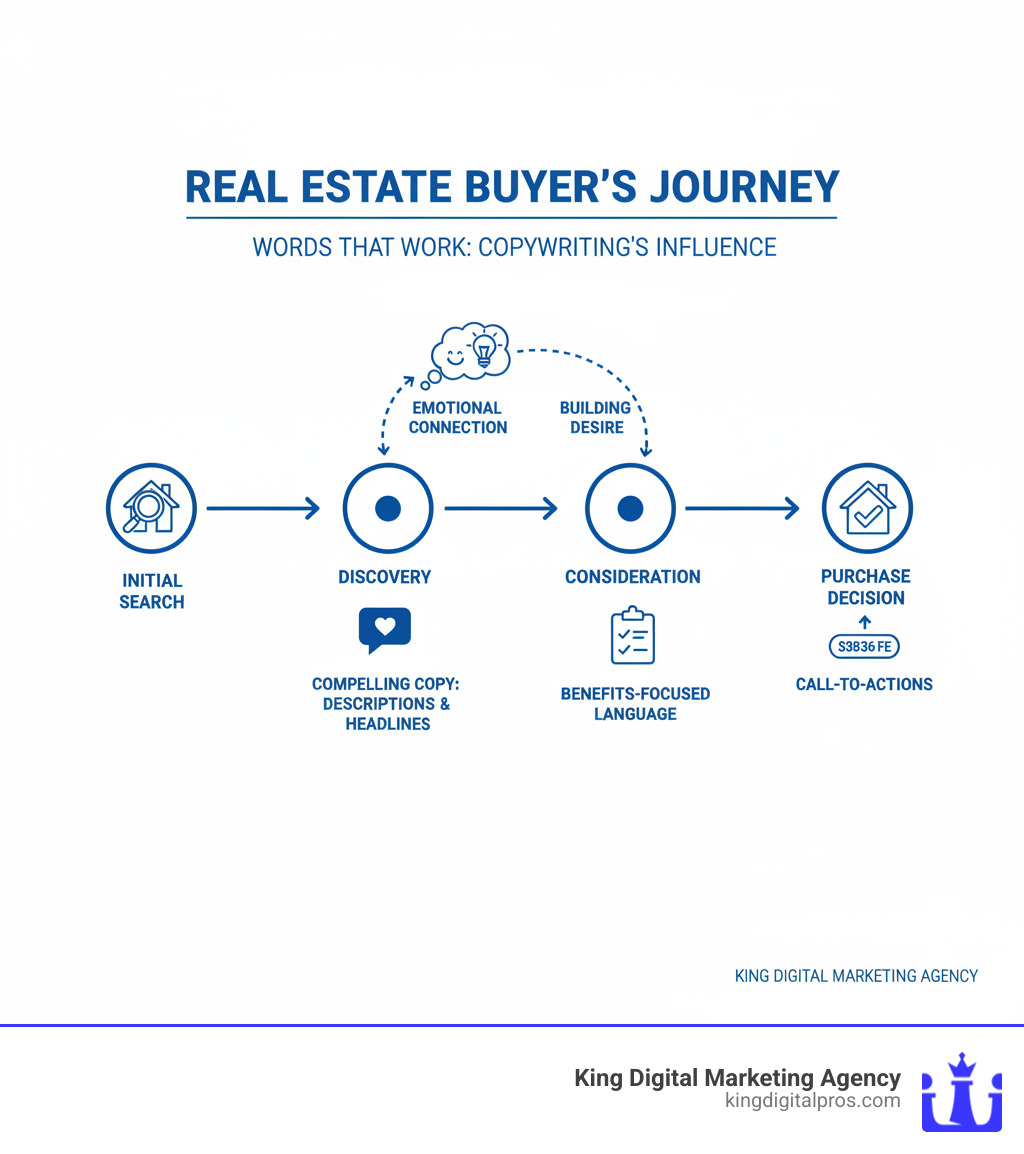Why Real Estate Copywriting Can Make or Break Your Sales
Real estate copywriting is the strategic art of crafting compelling written content that transforms property features into emotional benefits, turning casual browsers into serious buyers. In a digital-first world, where a buyer’s first interaction with a home is often online, the words you choose are as crucial as the photos you display. It’s about creating a narrative that allows potential buyers to envision their future within the walls of a property before they ever step inside.
Effective real estate copy is built on several key pillars:
- Attention-Grabbing Headlines: Your headline is the digital curb appeal. It must be powerful enough to stop a user from scrolling past your listing and create a sense of urgency or curiosity.
- Vivid Descriptions: This is where you move beyond listing facts and start painting a picture. The goal is to describe the lifestyle the home offers, not just the number of rooms and their dimensions.
- Benefit-Oriented Language: Buyers are motivated by what a home can do for them. Great copy translates features (like a large backyard) into tangible benefits (like a private sanctuary for family barbecues and a safe place for children to play).
- Clear Calls-to-Action (CTAs): After capturing their interest, you must guide prospects on what to do next, whether it’s scheduling a tour, viewing a virtual walkthrough, or contacting an agent.
- SEO Optimization: Integrating relevant keywords ensures your listings appear in front of the right audience on search engines and real estate platforms, maximizing visibility.
The numbers tell the story. With over 6.5 million homes sold in the US annually and countless agents competing for attention, your words are often the first – and sometimes only – chance to connect with potential buyers. As one industry expert noted, “Just like people eat with their eyes first, the same goes for real estate. People will first be attracted to pictures, and then the real ‘taste’ will be what they read from you.”
In today’s fast-moving market, compelling copy isn’t just helpful – it’s essential. The power of narrative is well-documented; according to research from Stanford, stories are up to 22 times more memorable than facts alone. This means your property descriptions need to do more than list square footage and amenities – they need to tell the story of the life a buyer could live there.
Strong copy also supports your broader marketing ecosystem. Listings rarely live in one place; they are mirrored across MLS feeds, major portals, social media captions, email subject lines, and Google Business Profile updates. Clear, consistent messaging helps you maintain brand voice wherever buyers find you, and it can improve engagement signals like click-throughs and inquiries. While Google considers many factors for local visibility, it explicitly evaluates relevance, distance, and prominence – all of which are easier to convey with accurate, high-quality descriptions and business information. See Google’s guidance on local ranking for details: https://support.google.com/business/answer/7091.
In practical terms, real estate copywriting shows up in:
- MLS and portal listings (driving findy and inquiries)
- Social posts and ads (capturing attention fast with benefit-led hooks)
- Google Business Profile descriptions and updates (reinforcing relevance for local searches)
- Website pages and landing pages (converting interest into tours and consultations)
For a deeper dive into why narrative-driven writing works, Stanford Graduate School of Business outlines how storytelling lifts persuasion and recall in business communications: https://www.gsb.stanford.edu/insights/why-storytelling-so-essential-business.
I’m Bernadette King, founder of King Digital Marketing Agency, and I’ve spent years helping businesses craft compelling copy that converts browsers into buyers. My experience with real estate copywriting has shown me that the right words can transform a property listing from forgettable to irresistible, turning casual interest into serious inquiries.

The Foundations of Compelling Real Estate Copy
Building effective real estate copywriting is like laying the foundation for a beautiful home – get it right, and everything else falls into place naturally. At King Digital, we’ve seen how the right words can transform a property listing from overlooked to irresistible.

The numbers tell a compelling story. According to the National Association of Realtors, with over 5.6 million existing homes and another 822,000 newly constructed homes sold in recent years, the competition for buyer attention has never been fiercer. Your listing description isn’t just marketing copy – it’s your first impression, your sales pitch, and often your only chance to connect with the perfect buyer.
Every successful property description rests on four crucial pillars: knowing your audience deeply, changing features into meaningful benefits, using language that creates vivid mental pictures, and guiding prospects with clear next steps. Mastering these foundations will help your listings generate more interest, more showings, and ultimately, more sales.
A practical note on presentation: most buyers skim on mobile. Use short paragraphs, bullets, and front-load key details so the value is clear in seconds. Research from Nielsen Norman Group shows that users scan rather than read every word, so scannable formatting improves comprehension and action: https://www.nngroup.com/articles/how-users-read-on-the-web/.
Writing Headlines that Grab Attention
Your headline is the digital equivalent of curb appeal – it’s what makes someone slow down and take a closer look. In today’s fast-scrolling world, you have mere seconds to capture attention before a potential buyer moves on. The most effective headlines are typically between 5-10 words and highlight what makes the property special.
Instead of generic phrases, focus on unique selling points (USPs). Is it the only home with a three-car garage in the neighborhood? Does it offer rare lakefront access? These are your headline heroes. Compare these:
- Before: Beautiful Home for Sale
- After: Just Listed: Sun-Drenched 4-Bedroom with Private Backyard Oasis
The AIDA model – Attention, Interest, Desire, Action – is a perfect framework. Grab Attention with a powerful USP. Build Interest with intriguing details. Create Desire by hinting at the lifestyle. Prompt Action with urgency (e.g., “Won’t Last Long”).
Create urgency with phrases like “Just Listed” or “New to Market,” but avoid clickbait that misleads. Use specific numbers when they add value: “5-Bedroom Colonial with 3-Car Garage” tells a clearer story than “Spacious Family Home.” Try writing three different headlines for each property to find the one that best captures its essence while speaking directly to your target buyer.
Additional headline angles you can test:
- Location-led: “North Valley Retreat Steps from Trails”
- Lifestyle-led: “Entertainer’s Dream with Seamless Indoor-Outdoor Flow”
- Scarcity-led (honest): “Rare Corner Lot with Mountain Views”
- Upgrade-led: “Fully Renovated, Energy-Efficient 3-Bedroom”
Translating Features into Benefits
This is where real estate copywriting becomes powerful persuasion. Buyers don’t just want to know what a home has – they want to understand how it will improve their life. Every feature should answer the buyer’s unspoken question: “So what?”
The secret is connecting property features to emotional triggers and lifestyle improvements. Instead of just stating “granite countertops,” paint a picture of “gleaming granite surfaces perfect for hosting memorable dinner parties and preparing family meals with ease.” One lists facts; the other sells a dream.
Consider your buyer’s deeper needs. Young families want safety and space. Empty nesters crave low maintenance and luxury. First-time buyers need affordability and quality. Each feature should speak to these desires.
| Feature | Benefit |
|---|---|
| Granite countertops | Durable, gleaming surfaces perfect for entertaining and daily meal prep. |
| Two-car garage | Protected parking plus valuable storage for seasonal items and hobbies. |
| Open floor plan | Create seamless family gatherings and enjoy an effortless entertaining flow. |
| Master suite on main level | Enjoy convenient single-floor living with improved privacy and accessibility. |
| Large backyard | Your private outdoor sanctuary for relaxation, play, and gardening. |
| New HVAC system | Stay comfortable year-round while saving money with a new, energy-efficient system. |
| Home office | A dedicated, quiet space to boost productivity and maintain work-life balance. |
Pro tip: use a simple formula to connect dots quickly – Feature + “so that” + Benefit. Example: “New dual-pane windows so that you enjoy quieter rooms and lower utility bills.”
The magic happens when you connect physical features to emotional benefits. A finished basement becomes “your family’s private retreat for movie nights and game day celebrations.” A walk-in closet transforms into “your personal dressing room where getting ready is a pleasure, not a chore.”
The Power of Descriptive Language
Great real estate copywriting engages the senses, helping buyers imagine themselves in the space. The right words can make a modest home feel cozy, while poor choices can make a mansion feel cold.
Sensory words bring listings to life. Instead of a “bright kitchen,” describe a “sun-drenched kitchen where morning light streams through the windows.” Rather than a “quiet neighborhood,” paint a picture of “peaceful tree-lined streets where the gentle rustle of leaves is the primary soundtrack.”
Use evocative adjectives like “sprawling,” “intimate,” “soaring,” and “tucked away” to create immediate visual images. However, your language must also be inclusive and compliant. It is crucial to avoid words that could violate the Fair Housing Act. Language that implies a preference for or against a certain type of buyer based on race, religion, familial status, or other protected classes is illegal. For example, avoid phrases like “perfect for singles” or “a quiet, mature community,” as they could be seen as discriminatory. Focus on describing the property, not the potential buyer.
Maintain accuracy and avoid exaggeration. Truth-in-advertising rules require you to be honest and substantiated in your claims. If you mention a recent upgrade or a brand-name appliance package, make sure it is verifiable. For guidance, consult the Federal Trade Commission’s overview on truthful advertising: https://www.ftc.gov/business-guidance/advertising-marketing/truth-advertising.
The tone you set depends on your property and audience. Luxury properties call for sophisticated language emphasizing exclusivity (“bespoke finishes,” “unparalleled views,” “curated design”). A family home needs warm, welcoming words that emphasize comfort and community (“charming,” “move-in ready,” “friendly neighborhood”). A downtown condo might focus on a vibrant, convenient lifestyle (“energetic,” “walkable,” “modern hub”).
You’re not just describing rooms – you’re setting the stage for someone’s future memories. Help them envision holiday gatherings in the dining room or quiet mornings on the back deck. When buyers can picture their life unfolding in your listing, they’re already halfway to making an offer.
Finally, guide readers with clear, low-friction next steps. Examples:
- “Schedule a private tour today”
- “Explore the 3D walkthrough”
- “Request the full features sheet”
- “Ask about our list of local lenders and incentives”
Pair these CTAs with visible buttons or links on your site and Google Business Profile posts so interested buyers can act immediately.

